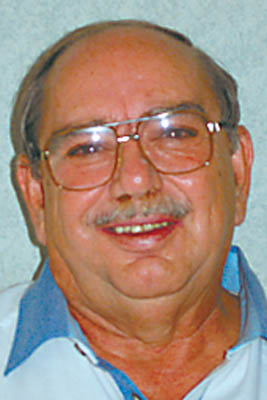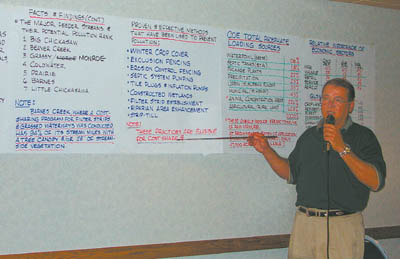By NANCY ALLEN
nallen@dailystandard.com
It was standing room only Wednesday night at the Celina Moose
Lodge where about 90 people attended a meeting to discuss how
to improve the water quality in Grand Lake St. Marys.
 A
community-based approach involving all types of citizens from
all walks of life is the best way to do it, meeting leaders
said. A
community-based approach involving all types of citizens from
all walks of life is the best way to do it, meeting leaders
said.
The gathering, billed as a lake restoration meeting, was headed
by Bill Ringo, Celina, and Vic Woodall, St. Marys, both members
of the nonprofit Lake Improvement Association.
“No one has all the ans-wers,” Woodall told the
crowd. “It will be a long hard battle, but we can improve
the condition of the lake.”
Ringo began with a 30-minute presentation on existing water
quality data that he gathered from the Ohio EPA, OSU Extension
and local watershed groups. Seventeen large sheets of paper
containing the handwritten information were taped to two walls
at the lodge.

The data touched on the amount of nutrients from manure that
often gets into the lake from farm field runoff. Mercer County
has the highest concentration of livestock of any county in
the state. There are some 203,900 cattle, milk cows and hogs
in the watershed, statistics show. Ringo also said there is
not enough farmland on which to properly spread the manure.
The prevention of sediment and the nutrients attached to the
sediment from entering the lake should be the group’s
No. 1 priority, Ringo said.
Woodall said the only way to improve the lake’s water
quality is to improve the quality of the water coming into the
lake. This can be done by implementing conservation methods
such as planting grass-covered filter strips along creeks and
streams that drain into the lake and grassed waterways through
farm fields that decrease soil erosion, he said.
“We hope to get politicians attention through mailings
and other ways,” Woodall said. “We have a lot of
votes, folks, and we want to make that known to the politicians.”
Woodall said there are members of the group who have volunteered
to help research. Several committees also were set up during
the meeting, including research/technical data, publicity/communications,
legal, sewer plants and others.
Mercer County Commissioner Jim Zehringer and Chickasaw resident
Ron Puthoff, a consultant known for his grant writing abilities,
volunteered to chair the committee that will look at concerns
at the sewer plants that serve small housing subdivisions in
the county, such as at Northwood along Ohio 703 where water
from the plant drains into the lake.
The creation of an enforcement committee charged with looking
at whether existing local, state and federal pollution laws
are being enforced properly also was suggested.
The group still is trying to decide whether or not it will stay
under the umbrella of the LIA or become its own entity. Another
meeting was scheduled for 7:30 p.m. Oct. 21 at the Moose.
The LIA more recently has become interested in lake water quality
issues. The group traditionally was associated with raising
funds for projects such as building shelter houses and picnic
tables around the lake.
Woodall said organizers decided to start the new group because
they are not satisfied with the progress of the existing watershed
groups — the Grand Lake St. Marys Watershed Project that
formed in 1999 and the Wabash Watershed Alliance that developed
in 2001.
Water quality testing in 1999 showed the Wabash River Watershed
in Mercer and Darke counties and the Grand Lake St. Marys Watershed
in Mercer and Auglaize counties had the most degraded water
quality of any in the state of Ohio. Most sections were ranked
poor while the rest were ranked fair. There were no areas ranked
good.
The 71,862-acre Grand Lake watershed, which drains into the
lake, is one of the most polluted in the state, the water quality
testing also showed.
In the lake, blue green algae flourishes and chokes off oxygen
for fish and other aquatic animals. The algae blooms when there
are high amounts of nutrients that come from manure runoff from
farm fields, agricultural and lawn fertilizers, human waste
that leaks from failing private septic systems and laundry and
dish soap.
What the group is trying to do boils down to stewardship, Woodall
said when asked by someone in the crowd to define the group’s
goal.
“Stewardship is people who accept the responsibility of
doing things right,” he said. “All we have to accomplish
is to do things right and if we do things right, the lake will
be preserved.”
|

